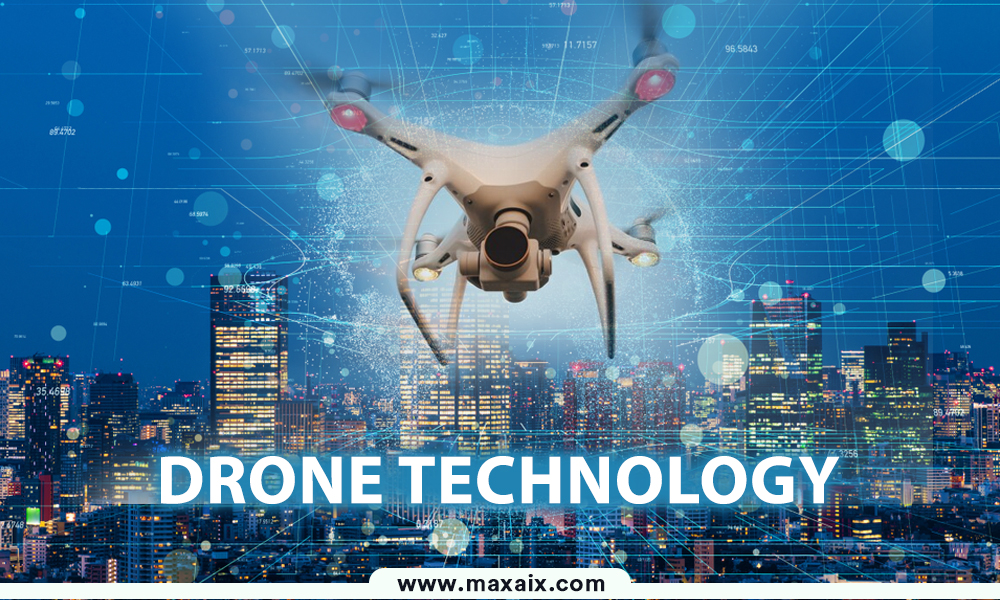Drone Technology

Drone technology, also known as unmanned aerial vehicle (UAV) technology, has transformed various industries and opened up new possibilities for applications in fields ranging from agriculture to filmmaking. In this comprehensive guide, we delve into the world of drones, exploring their functionalities, applications, and the technologies that power them.
What are Drones?
Drones, additionally known as Unmanned Aerial Vehicles (UAVs), are aircraft without human pilots onboard. Remotely controlled or autonomously flying, these devices use software-managed flight plans in their embedded systems, operating with GPS and other sensors. Initially advanced for military functions, drones have rapidly multiplied into diverse industries in commercial, recreational, agricultural, and clinical fields.
UAV Meaning
UAV stands for Unmanned Aerial Vehicle. These vehicles are essentially flying robots managed remotely or autonomously through software. They can range from small consumer-grade quadcopters to massive military-grade surveillance drones.
Types of Drones
Drones are available in numerous shapes and sizes, every one designed for unique functions:
- Quadcopters: These are the maximum not unusual kind of customer drones, offering 4 rotors for stability and maneuverability.
- Fixed-wing Drones: These drones resemble conventional airplanes, efficiently flying long distances and commonly used for aerial mapping and surveillance.
- Multi-rotor Drones: Like quadcopters, however with more than 4 rotors, those drones provide elevated stability and payload ability.
- Hybrid Drones: Combining the capabilities of each fixed-wing and multi-rotor drone, hybrids offer versatility in flight and payload competencies.
Features of Drones
Modern drones boast more than a few capabilities, which include:
- GPS Navigation: Enables positioning and automated flight routes.
- High-Resolution Cameras: Captures sharp snapshots and videos for various programs, such as photography, filmmaking, and surveillance.
- Obstacle Avoidance Sensors: Prevents collisions with gadgets during flight.
- Remote Control Systems: Allows users to govern drones from a distance using radio alerts or wireless connections.
- Autonomous Flight Modes: Offers pre-programmed flight paths and shrewd flight modes for simplified operation.
The Main Structural Elements of Drones
Drones include several key additives:
- Frame: The fundamental structure that holds all the components collectively.
- Propellers: Generate thrust to raise the drone off the floor and maneuver it inside the air.
- Motors: Power the propellers to reap flight.
- Battery: Provides vital power to the cars and other digital additives.
- Flight Controller: Processes commands from the pilot or self-reliant flight software program to stabilize and manage the drone.
- Sensors: Including gyroscopes, accelerometers, and GPS, to collect statistics for navigation and stabilization.
How Do Drones Work?
Drones perform based on a combination of aerodynamics, electronics, and software. Here’s a simplified overview of the way they work:
- Takeoff: The drone’s vehicles spin the propellers, generating thrust to raise it off the ground.
- Navigation: GPS and onboard sensors assist the drone in determining its position and orientation within the air.
- Stabilization: The flight controller adjusts the rate of individual Motors to keep stability and manipulate during flight.
- Remote Control: The pilot makes use of a handheld controller or a cellphone app to send commands to the drone, which include altitude, route, and speed.
- Autonomous Flight: Some drones can fly autonomously by following pre-programmed flight paths or using superior AI algorithms to navigate and make decisions in actual time.
Drone Technologies. How Does Drone Technology Function?
The drone generation incorporates various innovations that enable drones to carry out diverse obligations correctly. Key technologies encompass:
- Remote Sensing: Utilizing cameras, LiDAR, and other sensors to gather facts for mapping, surveying, and environmental monitoring.
- Communication Systems: Facilitating real-time conversation among the drone and ground manipulation stations, allowing for seamless operation and statistics transmission.
- Battery Technology: Advancements in battery technology have brought about longer flight times and increased payload capacity, enhancing the overall talents of drones.
- Collision Avoidance: Incorporating sensors and algorithms to discover and keep away from obstacles within the drone’s flight path, improving protection and reliability.
- Artificial Intelligence: Enabling drones to research records, make decisions, and adapt to changing environments autonomously, opening new possibilities for packages consisting of self-reliant delivery and seek and rescue operations.
The Advantages of Drones
Drones provide several benefits across diverse industries:
- Cost-Effective: Drones are frequently cheaper than conventional manned aircraft for obligations inclusive of aerial photography, surveillance, and infrastructure inspection.
- Efficiency: They can access faraway or dangerous regions that are tough or risky for human beings to reach, saving time and assets.
- Versatility: Drones can be ready with distinctive payloads and sensors to carry out an extensive variety of duties, from agricultural spraying to emergency reactions.
- Data Collection: They can gather high-resolution imagery and records for programs consisting of mapping, tracking crop fitness, and disaster evaluation.
- Environmental Impact: Drones consume much less fuel and bring fewer emissions than manned planes, making them an extra environmentally pleasant alternative for sure duties.
What Are Drones Used For?
Drones, with their versatility and a huge range of capabilities, are used throughout numerous industries for numerous functions, which include:
- Aerial Photography and Videography: Drones with high-resolution cameras capture stunning aerial photos for movies, real estate, and events.
- Surveillance and Security: Law enforcement, private security, and border control use drones for monitoring large areas and gathering intelligence.
- Search and Rescue: Drones with thermal imaging and sensors locate missing persons, disaster survivors, and individuals in dangerous environments.
- Agriculture: Drones monitor crops, control irrigation, and precisely spray fertilizers and pesticides to improve yields and reduce environmental impact.
- Infrastructure Inspection: Drones with cameras and LiDAR inspect bridges, power lines, and infrastructure for damage, aiding in maintenance and accident prevention.
- Delivery Services: Companies like Amazon and UPS explore drone delivery for quick, efficient package transport, especially in remote areas.
Drone Usage Areas
The utility areas of the drone era are significant and usually increasing. Some awesome sectors in which drones are considerably used encompass:
- Military and Defense: Drones are crucial for surveillance, reconnaissance, and targeted strikes, reducing human risk and providing valuable intelligence.
- Construction and Engineering: Drones improve efficiency and safety in site surveying, project monitoring, and 3D mapping while cutting costs.
- Environmental Conservation: Drones aid in wildlife monitoring, habitat mapping, and anti-poaching efforts, protecting endangered species and ecosystems.
- Emergency Response and Disaster Relief: Drones provide aerial assessments, deliver medical supplies, and support search and rescue missions in disaster situations.
- Media and Entertainment: Drones capture dynamic aerial footage for filmmaking, sports broadcasting, and live events, enhancing storytelling and viewer engagement.
- Oil and Gas Industry: Drones inspect pipelines, flare stacks, and offshore platforms, reducing the need for manual checks and minimizing safety risks.
Advance Drone Technology
Drone technology keeps adapting rapidly, driven with the aid of ongoing research and improvement efforts. Some latest advancements include:
- Longer Flight Times: Improved battery technology extends drone flight times, boosting mission productivity.
- Higher Payload Capacities: Enhanced designs allow drones to carry heavier payloads like high-res cameras and LiDAR sensors.
- Improved Sensors and Imaging Systems: Advances in sensors and cameras capture more detailed and accurate data.
- Autonomous Navigation: AI and machine learning enable drones to navigate, avoid obstacles, and make real-time decisions.
- Swarm Technology: Multiple drones collaborate for complex tasks like environmental monitoring and disaster response.
Barriers to Drone Technology
Despite the rapid advancements in the drone era, numerous obstacles prevent its huge adoption and integration into numerous industries:
- Regulatory Challenges: Complex and evolving policies for drone operations, airspace regulations, and privacy issues present significant obstacles for businesses and individuals.
- Safety Concerns: Risks of mid-air collisions, flyaways, and unauthorized flights pose dangers to people, property, and other aircraft, causing concern among regulators and the public.
- Limited Endurance: Most industrial drones have restricted flight times due to battery constraints, limiting their effectiveness for long-duration missions.
- Security Risks: Drones are vulnerable to hacking, spoofing, and other cybersecurity threats, posing risks to data integrity, privacy, and national security.
- Public Perception: Negative views on drones, driven by privacy invasion, surveillance, and potential misuse concerns, hinder acceptance and adoption by the public and policymakers.
Drone Regulations
Regulations governing drone operations from country to country. And are concerned with frequent updates and revisions. Some common regulations include:
- Registration: Drone operators in many countries must register their drones with aviation authorities and obtain a unique identification number to fly legally.
- Licensing and Certification: Commercial drone operators may require licenses or certifications to demonstrate their ability to operate drones safely and comply with regulations.
- Flight Restrictions: Drones are typically prohibited from flying in restricted airspace near airports, military installations, and government buildings to ensure aviation and national security.
- Operational Limitations: Regulations may restrict drone flight altitude, speed, and proximity to people, vehicles, and structures to enhance public safety and privacy.
- Privacy Protections: Drone operators must respect privacy rights by avoiding capturing or sharing images and videos without consent, especially in sensitive or private areas.
Today’s Uses of Drone Technology
In modern global, drone technology is being applied in various ways across various sectors:
- Delivery Services: Companies like Amazon Prime Air and Wing use drones for speedy, efficient delivery to customers’ doorsteps.
- Precision Agriculture: Farmers utilize drones with multispectral cameras and sensors to monitor crops, optimize irrigation, and precisely apply fertilizers and pesticides, improving yields and reducing environmental impact.
- Emergency Response: Drones help responders assess disaster damage, locate survivors, and deliver medical supplies and communication devices quickly and safely.
- Infrastructure Inspection: Utility companies inspect power lines, bridges, and pipelines with drones to detect wear, corrosion, or damage, enhancing maintenance efficiency.
- Environmental Monitoring: Conservation groups monitor wildlife, track illegal logging, and map ecosystems using drones to support conservation efforts and policy decisions.
- Entertainment and Recreation: Hobbyists enjoy drones for aerial photography, racing, and FPV flying, combining the thrill of flight with creative expression.
The Future of Drone Technology
The destiny of drone technology holds immense potential for innovation and increase:
- Urban Air Mobility: Urban air taxis and drone delivery services promise faster, eco-friendly transportation solutions for cities and businesses.
- Advanced Sensor Integration: Drones use LiDAR, hyperspectral imaging, and SAR for precise data in environmental monitoring, infrastructure inspection, and disaster response.
- AI-Powered Automation: AI enables drones for tasks like swarm surveillance, predictive maintenance, and collaborative mapping, enhancing efficiency.
- Expanded Healthcare Applications: Drones aid healthcare logistics, transporting organs, managing medical supply chains, and offering telemedicine to remote areas.
Conclusion
Drones continue to reshape industries, enhancing performance across diverse sectors from aerial photography to emergency response. Despite regulatory challenges, their role in transportation, commerce, and society is set to expand as technology advances and public acceptance grows.
Frequently Asked Questions
How Do Drones Work?
Drones operate using remote control systems or autonomous flight software, powered by onboard sensors, GPS, and communication systems, to navigate, stabilize, and perform tasks in the air.
What Are the Different Types of Drones?
Drones come in various forms, including quadcopters, fixed-wing drones, multi-rotor drones, and hybrid drones, each designed for specific purposes and applications.
What Are Some Common Uses of Drones?
Drones are used for aerial photography, surveillance and security, search and rescue operations, agriculture, infrastructure inspection, delivery services, and entertainment.
What Are the Advantages of Drone Technology?
Drones offer benefits such as cost-effectiveness, efficiency, versatility, data collection capabilities, and reduced environmental impact compared to traditional manned aircraft.
What Are Some Challenges Facing Drone Technology?
Challenges include regulatory hurdles, safety concerns, limited flight endurance, security risks, and negative public perception surrounding drones.
How Are Drones Regulated?
Drone regulations vary by country and often include requirements for registration, licensing, flight restrictions, operational limitations, and privacy protections.
What Are Some Future Trends in Drone Technology?
Future trends include urban air mobility, advanced sensor integration, AI-powered automation, expanded applications in healthcare, and continued innovation in drone design and capabilities.


